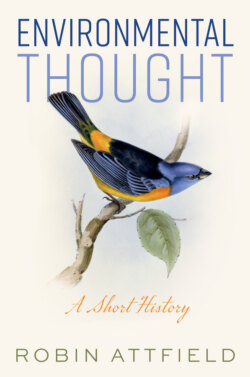Читать книгу Environmental Thought - Robin Attfield - Страница 19
Early Christianity
ОглавлениеSome of the Church Fathers have been cited as sources of inspiration by modern environmentalists. The theologian Paul Santmire, for example, finds a neglected but ecologically promising motif in the second-century Christian theologian Irenaeus, who wrote of the whole cosmos being renewed in the end times: ‘The whole creation shall, according to God’s will, obtain a vast increase, that it may bring forth fruits such as Isaiah declares (30:25–26)’; indeed, it ‘is full of goodness, harmony, beauty, and life at all times’ (Santmire 1985: 43). And then there is Chrysostom’s teaching (in the fourth century) about the beasts – ‘Surely we ought to show them great kindness and gentleness for many reasons, but above all because they are of the same origin as ourselves’ – which has been cited with approbation by C. W. Hume (1957: 26) and Andrew Linzey (1976: 103). Basil the Great (c. 331–79 CE) prayed for ‘the humble beasts who bear with us the heat and burden of the day’ (Passmore 1974: 198), suggesting that the attitudes of the book of Proverbs persisted into the patristic period. However, others, such as Origen (third century CE), seem to have adhered to a more anthropocentric stance, holding that the creator has made everything to serve rational beings (Glacken 1967: 185–6).
Nevertheless, Glacken attests the widespread presence of the belief among the Church Fathers, including Ambrose (fourth century CE) and Theodoret (fifth century CE), that humanity has the role of adorning and perfecting God’s creation (1967: 192, 299, 300). There again, implicit belief in the human role as stewards of nature was also found among Christians such as Cosmas Indicopleustes (early sixth century), who writes of humanity completing and adorning the house of creation which God has prepared (Glacken 1967: 300–1). Yet these are precisely the two ancient traditions which Passmore (an admirer of Glacken) detects in pagan antiquity, and then (amazingly) as absent across the entire period of early Christianity and the Middle Ages (Passmore 1974: 28–34).
A frequent literary form among early Christians was that of commentaries on the six days of creation, each bearing the name of ‘Hexaemeron’. This tradition was pioneered by the first-century CE Jewish writer Philo (Glacken 1967: 187–9); its most celebrated exponent was Basil the Great, whose work became known in the West through the Latin hexaemeron of Ambrose, which was based on it. Basil’s work was praised many centuries later by von Humboldt in Cosmos, his major work of the early nineteenth century(Glacken 1967: 177: for von Humboldt, see Chapter 2).
One passage of Basil’s work illustrates well the theme of an unfinished Earth which God has yet to complete with the aid of human farming and arboriculture: ‘For the proper and natural adornment of the earth is its completion: corn waving in the valleys – meadows green with grass and rich with many-coloured flowers – fertile glades and hill-tops shaded by forests’ (Glacken 1967: 192). Phrases from this sentence about the completion of God’s creation were echoed to convey much the same message more than a thousand years later by the English naturalist John Ray (1627–1705). Such passages give the lie to the once-popular claim that early and medieval Christians lacked an awareness of natural beauty.
Augustine (354–430) too wrote a hexaemeron. Although, as we have seen, he adhered to a kind of anthropocentrist theology (everything being made, in his view, either for human benefit or for the glorification of God), he importantly countered aspects of Origen’s degraded view of creation (see Santmire 1985), holding that life on Earth and the beauties of nature are not to be despised because they are low in the scale of being (Glacken 1967: 196). (For the great chain of being, see the subsection above on Aristotle and Theophrastus.) For Augustine, indeed, God is immanent in the world, and also transcends it (Santmire 1985: 208; Peacocke 2007: 22; Attfield 2016: 96). Rather surprisingly, in view of his usual reputation, Augustine also praises the achievements of human art and invention (agriculture and navigation included), and was one of many to argue to God from the beauties of the world.
Ask the loveliness of the earth, ask the loveliness of the wide airy spaces, ask the loveliness of the sky, ask the order of the stars … ask all these things, and they will all answer thee, Lo, see we are lovely. Their loveliness is their confession. And these lovely but mutable things, who has made them, save Beauty immutable? (Glacken 1967: 200; Vivès 1872–8, vol. 18: 237–45)
Despite the fallen nature of humanity, human beings participate fully in the order of creation (Glacken 1967: 200), an order that retains its created goodness, and can, as in the passage cited, serve as a profound source of wonder.
Augustine also continued the tradition, present already in Chrysostom, of comparing nature to a great book, and one which, as he wrote, even the unlettered can read (Glacken 1967: 204). Reflection on nature as one of God’s two books (the other being the revelation as conveyed in the Bible) has echoed down the centuries, being taken up (for example) in the seventeenth century by Francis Bacon (1561–1626) and Galileo (1564–1642), and in the nineteenth by the American naturalist John Muir (1838–1914). Those who could understand this book could at least begin to experience wonder, and to feel awe before its creator. This sense of awe and wonder has proved to be (as in Muir’s case) one of the central springs of modern environmentalism.
